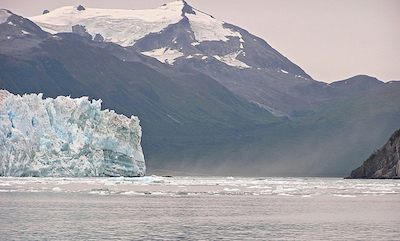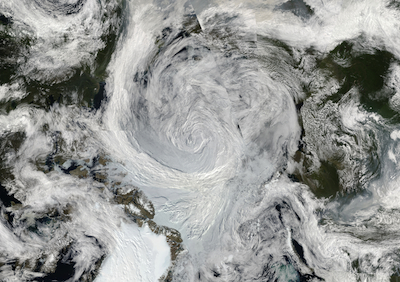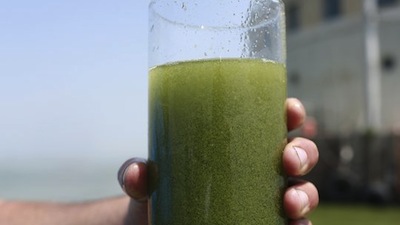
You may forward Planet Waves Monsanto Eco to your friends. They can sign up for this free environmental newsletter from Planet Waves. View this edition as a webpage. Dear Friend and Reader: Researchers at Oregon State University have compared marine sediment core samples from the North Pacific and North Atlantic oceans to determine that when those bodies of water synchronize in warming, climate shifts happen faster -- in fact, nearly instantly -- though the results play out over centuries, the university reported July 24.
"As the systems became synchronized, they organized and reinforced each other, eventually running away like screeching feedback from a microphone," Mix explains. "Suddenly you had the combined effects of two major oceans forcing the climate instead of one at a time." Among those "combined effects" is the amplified transport of heat toward polar regions, which causes ever-larger fluctuations in climate. While the team's detailed look at paleoclimatic records offers a vivid picture of the past that extends far beyond modern climate recordkeeping, there's no way to know if the same series of events will happen again. Even so, Praetorius notes, "Our study does suggest that the synchronization of the two major ocean systems is a potential early warning system to begin looking for the tipping point." Larger Arctic Waves Feed Global Warming Cycle Hopefully we can avoid reaching the 'tipping point' in our current climate situation. But as climate change melts the arctic ice cap, waves on the Arctic Ocean are getting bigger and accelerating the process, LiveScience reported July 31.
"It is possible that the increased wave activity will be the feedback mechanism which drives the Arctic system toward an ice-free summer," write Jim Thomson of the University of Washington and Erick Rogers with the Naval Research Laboratory in the journal Geophysical Research Letters, according to National Geographic. Larger waves on the Arctic Ocean could cause unprecedented erosion of shorelines, creating a hazard to navigation, as well as endangering polar bears and other arctic animals by exacerbating global warming. Holy Toledo -- Don't Drink the Water! In other water-related news, almost half a million Ohio residents were warned not to drink their contaminated tap water this week, the Los Angeles Times reported Saturday. As of Monday, the mayor of Toledo had lifted the ban. Municipal water supplies had tested positive for the toxin microcystin at a Toledo treatment plant, likely the result of an algae bloom in Lake Erie; a state of emergency was quickly declared in three counties.
The warning also read, "This drinking water alert does NOT recommend boiling, and in fact, boiling water can worsen the situation." This is the second time an Ohio city has had to instate a drinking water ban; swimming bans in Lake Erie due to harmful algae blooms are common -- and point to a lake in trouble. Algae blooms result from excess phosphorous and nitrogen, such as produced by fertilizer runoff, broken septic systems and industrial pollution. Lake Erie is the most intensely developed of the Great Lakes; but toxic algae blooms are becoming increasingly common across the U.S., with no signs of slowing down. Former Fukushima Execs May Face Criminal Charges Three former executives of the operator of the Fukushima Daiichi nuclear power plant in Japan may again face criminal charges for their role in the 2011 nuclear disaster, the Associated Press reported July 31. An independent judicial panel including citizens of Fukushima has appealed a decision made by prosecutors last September to drop a case against six executives of Tokyo Electric Power Company (TEPCO) due to a lack of evidence. "It is outrageous that nobody has faced criminal responsibility in the Fukushima Daiichi accident that has caused tremendous and serious damage," said Hiroyuki Kawai, a lawyer representing the plaintiffs. The prosecutors must now decide whether to indict the executives after a reinvestigation. Let the Sun Shine In… Maine
Kennebec Valley Community College in Fairfield will use its portion to fund a part-time manager for a high-efficiency solar-powered greenhouse on campus. "It's the perfect timing for us to build a photovoltaic greenhouse," said Richard Hopper, president of the college, which offers programs in sustainable energy, sustainable agriculture and a new farm-to-table culinary arts program. The University of Maine's Climate Change Institute in Orono, Olivia's Garden in New Gloucester, and Little River Flower Farm in Buxton will share the grant money. One More Reason to Bring Your Own Coffee Mug Styrene, a chemical in commonly used plastics like foam coffee cups and food containers, has been classified as a "reasonably anticipated human carcinogen," reported Newsday July 28. The National Research Council's decision upheld the findings from a 2011 report, which cited sufficient evidence of DNA damage to human cells exposed to styrene. Many groups battling the plastics industry consider the announcement a welcome victory. Executive director of Grassroots Environmental Education Patti Wood commented, "The fact that it is used so ubiquitously as a material for food and drink made us focus on it, especially where children are being exposed every single day. So this is good news." Message in a Bottle? The Message Is the Bottles In more-lighthearted packaging news, more than 157,000 plastic bottles are being used in Romania in what is intended to be the largest plastic bottle structure in the world, according to a Times of India report on July 24. The project is meant to bring attention to the massive amounts of litter dumped into rivers and oceans across the globe.
The volunteers constructed a bridge out of bottles tied together with polypropylene ropes. The bridge crosses the Bega River in Romania and can support more than 200 people. It will be on display until Aug. 8, and then will be recycled. Be-Littler? You've Got to Be-Kiddinger. Between lawsuits needed to bring polluters to justice, massive art happenings used to call attention to environmental issues, and the reliance on grant money just to get basic alternative energy projects off the ground, one has to wonder: would engineering human beings to have a smaller environmental footprint be a more effective way to slow global warming than simply trying to get people to do the right thing? At least three researchers think so, reported The Guardian's Improbable Research blogger Marc Abrahams July 28. S. Matthew Liao, a professor of bioethics at New York University, along with Anders Sandberg and Rebecca Roache, fellows who study ethics at the University of Oxford, first introduced their "be-littler" idea in 2012 in the journal Ethics, Policy and the Environment. Suggesting that biomedical engineering of human beings would be voluntary and "possibly supported by incentives such as tax breaks or sponsored healthcare," their proposed projects include: modifying people (either genetically or with drugs) to feel nauseous when they eat meat, thereby shrinking the meat industry's harmful impact; modifying people's minds (again, genes or drugs) "to enhance our moral decisions by making us more altruistic and empathetic"; and simply making people smaller (in height, weight or both) to reduce energy and food consumption, and general wear and tear on surroundings. Talk about a slippery slope. Let's just make smarter, less-wasteful choices, okay? Yours & truly, Amanda Painter and the ECO editorial team You may forward Planet Waves Monsanto Eco to your friends. They can sign up for this free environmental newsletter from Planet Waves. View this edition as a webpage. Planet Waves Monsanto Watch (ISSN 1933-9135) is published each Tuesday evening in Kingston, New York by Planet Waves, Inc. Editor and Publisher: Eric Francis Coppolino. Business Manager: Chelsea Bottinelli. Web Developer: Anatoly Ryzhenko. Research, Writing and Editing: Planet Waves Monsanto Watch is produced by a team consisting of Elizabeth Michaud, Amanda Moreno, Amanda Painter, Amy Elliott, Carol van Strum, Len Wallick and Chad Woodward.  Good as Gold: The Planet Waves Midyear Reading If you have not already noticed, 2014 is really two years in one, with version 2.0 beginning right about now. With all of the inner planets direct, Jupiter entering a fire sign and Mars coming home to its native Scorpio, a whole new concept of life and of astrology is reaching out to us. I will be unfolding this brand new aspect pattern for all 12 signs and rising signs in my midyear reading, called Good as Gold -- which I am recording this week.
I will provide ideas, strategies, motivational rants (my specialty) and ideas I've learned in therapy to get the blocks out of the way, access your courage, and invoke your vision for yourself. How do you manage the transition out of something old that is not really working and into something new, with the simultaneous demands of a learning curve, balancing yourself financially and staying inspired? These and other things are what I will be exploring. Good as Gold is available for pre-order now at $49.95 for all 12 signs. We start with the lowest price for all 12, gradually raise the price, then sell one reading for about what we were initially asking for all 12. Now is the time to get the best rate on the whole package, so you can listen to your Sun, Moon and rising signs, and check in with the readings for your collaborators. Here is that link Lovingly,  To unsubscribe, click here e Wiki | Friends | Editors | Contact Us Copyright © 2013 by Planet Waves, Inc. All Rights Reserved. Other copyrights may apply. Some images used under Fair Use or Share Alike attribution. |





